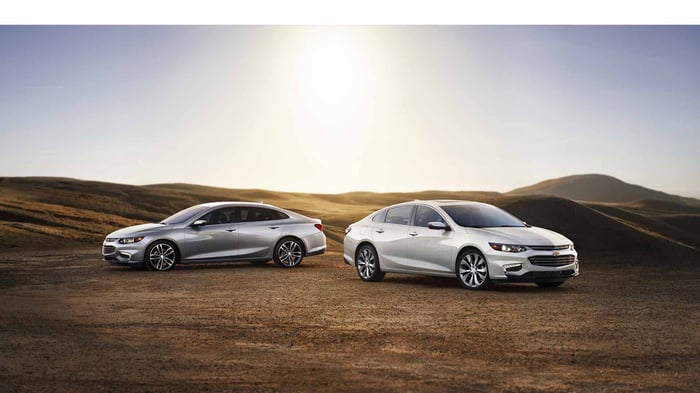Ford Motor (F 1.70%) is getting out of the car business in the United States. In conjunction with its first-quarter earnings report, the automaker announced that by 2020, almost 90% of Ford's North American model lineup will consist of trucks, utilities, and commercial vehicles.
As part of this transition, Ford will discontinue five key models in the domestic market: the Fiesta, C-MAX, Focus, Fusion, and Taurus. This radical decision has received mixed reviews from investors and auto industry pundits. Some view it as a smart move to eliminate unprofitable lines of business, while others see the shift away from cars as shortsighted. Let's take a look at some of the key arguments on both sides.
The end of the Ford sedan
By 2020, Ford will sell just two car models in North America: the Mustang and the forthcoming Focus Active. Neither is a traditional sedan -- or hatchback, for that matter. The iconic Mustang is a high-performance pony car, while the Focus Active will feature higher ground clearance than the current Ford Focus, making it closer to a crossover. (Indeed, Ford CEO Jim Hackett described it as a crossover last week.)
The segments Ford is abandoning have been declining, but they still represent a significant piece of the market. During the first three months of 2018, Ford sold 100,956 vehicles in the U.S. across the five models that will be discontinued. This was down 12.2% year over year, but it still represented 17.5% of the Ford brand's U.S. sales volume.

The Ford Fusion is one of five car models that Ford will drop in the U.S. Image source: Ford Motor Company.
At an industry level, cars are still expected to account for about 27% of consumer vehicle purchases in 2022, according to LMC Automotive. Thus, Ford is walking away from market segments that will continue to be important for the foreseeable future.
The case for dumping the car models
While Ford still sells a fair number of cars in the U.S., models like the Fiesta, Focus, and Fusion all lose money today. Many are delivered to rental car companies at bargain-basement prices. In the consumer market, Ford has to offer massive discounts to move cars off of its dealers' lots.
Crossovers are far more profitable, largely because consumers tend to see them as more desirable. Additionally, the difference in price between sedans and crossovers has narrowed in recent years. Indeed, in January, Ford began U.S. sales of the EcoSport: its first entry-level crossover for the domestic market. The starting price is just $19,995, though a typically equipped version would cost significantly more.
If consumer preferences are set to continue shifting toward crossovers, it makes sense for Ford to double down on that slice of the market.
Crosstown rival General Motors (GM -1.68%) is moving in a similar direction. It is working to broaden its crossover lineup with an ever-expanding array of models. And while GM doesn't plan to exit the U.S. car market entirely, it is likely to discontinue at least two models in the next few years: the Chevy Sonic and the Chevy Impala.
This is still a risky move
Historically, one reason automakers like Ford and GM built small cars was to draw potential customers into dealerships with cheap cars and then "upsell" them to more profitable models. The arrival of the EcoSport means Ford will still have an affordable entry-level model to fill this role. However, its starting price is nowhere near the Ford Fiesta's base price of $14,205.
Rising fuel prices potentially represent an even bigger risk to Ford's strategy. Cheap gas has certainly fueled the market shift toward crossovers over the past few years. However, the national average gasoline price has risen by more than $0.40/gallon over the past year.
It's true that today's crossovers are far more fuel efficient than the SUVs of a decade ago. But the added height of a crossover carries an automatic fuel efficiency penalty. For example, the new EcoSport gets an EPA-estimated 29 miles per gallon (mpg) on the highway, compared to 34 mpg for the Focus and 35 mpg for the Fiesta. If gas prices continue rising, the superior fuel efficiency of traditional compact cars could become a key selling point again.
The case for the middle ground
It's clear that Ford has been building far too many car models in recent years. The same is true for GM. Falling demand for traditional sedans and hatchbacks has undermined the already-tenuous business case for these models.

GM has also been suffering from weak demand for traditional sedans. Image source: General Motors.
However, eliminating traditional car models doesn't seem sustainable. Entry-level crossovers can't rival the fuel efficiency of a compact or subcompact car, and the difference in price is meaningful for cost-conscious buyers. Adding hybrid or battery-electric crossover models can address fuel-efficiency concerns, but at the cost of making those vehicles even more expensive. (Higher interest rates will make it even harder for consumers to afford the rising cost of buying a new vehicle.)
GM is somewhat better-positioned than Ford because it updated the high-volume Chevy Cruze and Chevy Malibu models a couple of years ago. It can keep those models alive for several more years without making major investments.
Still, given that Ford will continue making cars for other global regions -- and will build the car-derived Focus Active crossover for the U.S. market -- Ford should have been able to keep selling one or two sedans in the U.S. at an acceptable cost. Instead, it risks exiting a substantial slice of the market just as rising fuel prices and higher interest rates may push consumers back toward affordable, fuel-efficient cars.





